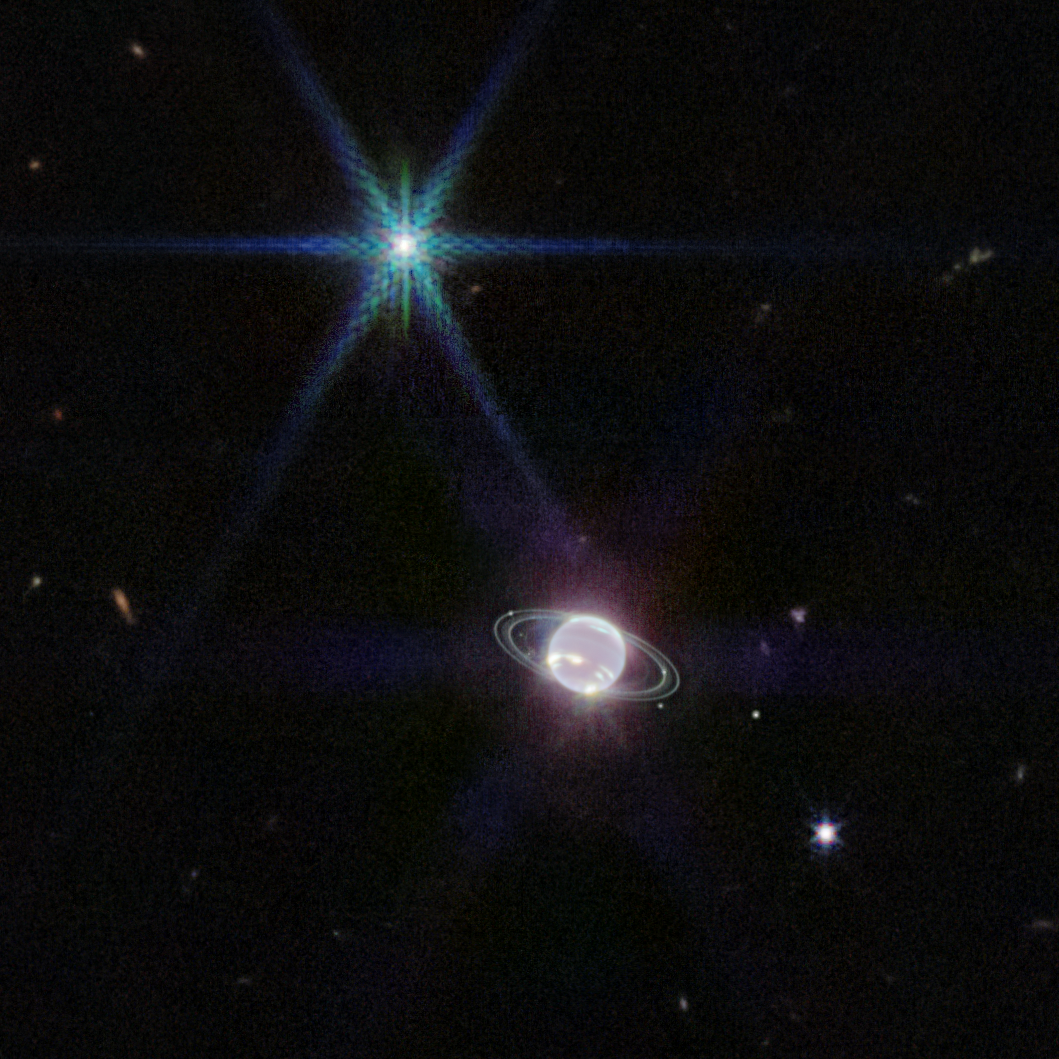I think that's Black Hole speak for "Feed me! Feed me!"

I think that's Black Hole speak for "Feed me! Feed me!"



NASA’s James Webb Space Telescope shows off its capabilities closer to home with its first image of Neptune. Not only has Webb captured the clearest view of this distant planet’s rings in more than 30 years, but its cameras reveal the ice giant in a whole new light.
Uh-oh indeed - can't send up a space shuttle to fix this one.
Slightly dissapointed with this image. I've seen Saturns rings with a 100mm (near toy) telescope sat on my drive in a fairly light polluted location. I'd sort of expected JW to be able to do better.

New Webb Image Captures Clearest View of Neptune’s Rings in Decades - NASA
NASA’s James Webb Space Telescope shows off its capabilities closer to home with its first image of Neptune. Not only has Webb captured the clearest view of this distant planet’s rings in more than 30 years, but its cameras reveal the ice giant in a whole new light.www.nasa.gov
JSmith
Especially since the Space Shuttle has been retired/decommissioned.can't send up a space shuttle to fix this one.
I believe it is to do with this;Slightly dissapointed with this image. I've seen Saturns rings with a 100mm (near toy) telescope sat on my drive in a fairly light polluted location. I'd sort of expected JW to be able to do better.
While Neptune appears blue in visible wavelengths due to methane gas in its atmosphere, that methane absorbs the infrared light that JWST observes, so the planet appears a sort of glowing white colour when viewed in these wavelengths. The brightest areas are icy clouds high in the atmosphere, which reflect sunlight before methane can absorb it.

More the general clarity than colour TBH.Especially since the Space Shuttle has been retired/decommissioned.
I believe it is to do with this;

JWST has captured an astonishing view of Neptune and its rings
A new image from the James Webb Space Telescope shows eight of Neptune’s moons and four of its rings – two of which haven’t been seen in more than 30 yearswww.newscientist.com
JSmith
That only works with doppler shifted light where there are relativistic speeds involved. Won't apply to local objects such as Saturn. JW is measuring only in the IR, so that is what we get.Do you know if they provide somewhere an equivalence of color in the images to real wavelengths measured? A sort of table would do the job.
Why do you guys always complicate things when talking physics?That only works with doppler shifted light where there are relativistic speeds involved. Won't apply to local objects such as Saturn. JW is measuring only in the IR, so that is what we get.
Slightly dissapointed with this image. I've seen Saturns rings with a 100mm (near toy) telescope sat on my drive in a fairly light polluted location. I'd sort of expected JW to be able to do better.

Now, I feel foolish.You do realize that Neptune is more than twice the distance away and less than half the size of Saturn, and a heck of a lot less luminous to boot? I was blown away with the clarity of this image, especially from an infrared telescope. The full image of the entire Nuptunian system is spectacular.

Martin
Saturn's rings are predominantly icy and very reflective, Neptune's contain lots of less reflective dust.Slightly dissapointed with this image. I've seen Saturns rings with a 100mm (near toy) telescope sat on my drive in a fairly light polluted location. I'd sort of expected JW to be able to do better.
In general you take the wavelengths of an image like in this case infrared, and filter it so the lower third in wavelengths is rendered in a greyscale, and do the same for the middle third and upper third by wavelength. You then assign red, green and blue to these making them red-scale, green-scale and blue-scale images. And combine them for a visible false color image. The exact percentages of assigned wavelengths and such can vary for other purposes, but this is in general how it is done.Why do you guys always complicate things when talking physics?Measured wavelength is measured wavelength. Another things is that knowing that the sources can't produce that wavelength due to its nature, one infers that they are moving and that explains its color anomaly. From that point, one can infer velocity of distant starts by analyzing their color anomaly.
By the way, a traffic radar uses the same principle, using microwaves, to measure car speed, which is way below the speed of light, because the bounced wave has a slightly different wavelength.
Anyway, that was not my point.
JW measures IR and a bit of visible, red to us, so it's impossible that we can se any other color from an image taken by it, white of course not. The folks at NASA take the original image and apply a transformation from raw measured wavelengths to visible spectrum. However, the range the JW measures is wider than visible, so it's not a direct relation. Somewhere, there is a rule to convert the frequencies/wavelengths from the JW to visible ones to build this images. I was asking if someone knew about it.
Now, I feel foolish.
I saw rings and thought "saturn". I don't think I even knew Neptune had rings.


Every day is a school day here at ASREasy mistake to make at first glance. This images show Neptune's rings very well. Jupiter and Uranus also have rings.
Jupiter:

Uranus:

Martin
ThanksIn general you take the wavelengths of an image like in this case infrared, and filter it so the lower third in wavelengths is rendered in a greyscale, and do the same for the middle third and upper third by wavelength. You then assign red, green and blue to these making them red-scale, green-scale and blue-scale images. And combine them for a visible false color image. The exact percentages of assigned wavelengths and such can vary for other purposes, but this is in general how it is done.
Did someone fool around to make them pretty? I don't know...maybe.Thanks
Whenever I see nice pictures of something on the universe I tend to think that someone has taken some liberties to translate the original image to the published one. This Neptune one looks more credible than the first ones to me. I don't mean the other are fake, but it's hard to believe the isn't a human touch on them.
By the way, a traffic radar uses the same principle, using microwaves, to measure car speed, which is way below the speed of light, because the bounced wave has a slightly different wavelength.
